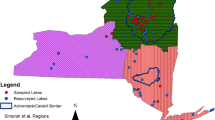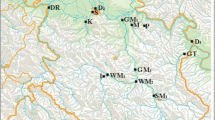Abstract
This paper presents a summary of the current status and temporal trends over the past 15 - 20 years in contaminant levels in sport fish and juvenile forage fish in the Canadian waters of the Great Lakes. Fish consumption advisories summarized from the 1995 Guide to Eating Ontario Sport Fish showed that 67% of the 1736 consumption advisories in the Canadian waters of the Great Lakes had no restrictions. In the remaining 33% of the advisories, consumption of sport fish was restricted to 4 meals per month or less. Lake Erie had the fewest consumption restrictions (19%) and Lake Ontario the most (45%). PCBs were the principal contaminants of concern responsible for 47% of the consumption restrictions in the Canadian waters of the Great Lakes and caused the most consumption restrictions in each of the Great Lakes except Lake Superior where toxaphene caused 69% of the consumption restrictions. Concentrations of PCBs in sport fish declined in Lake Huron and Lake Ontario over the period 1976-1994. A decline in mirex concentrations in sport fish from Lake Ontario was also observed over the same time period. Concentrations of Hg in sport fish from Lake St. Clair declined over the period 1970-1994, but mercury in sport fish showed no trend over time in Lake Huron or Lake Ontario over the period 1981-1994. Contaminant levels in juvenile forage fish collected in 1993 and 1994 at 44 locations in the lower Great Lakes were assessed against wildlife protection guidelines. Concentrations that exceeded the Forage Fish Contaminant Index were observed at 17 locations with PCBs being the principal contaminant of concern. PCB concentrations in spottail shiners declined at 12 of 16 locations monitored in the lower Great Lakes over the period 1975-1994.
Similar content being viewed by others
References
Cox, C., Vaillancourt, A. and Hayton, A.: 1993, ‘The Results of the 1992 Guide to Eating Ontario Sport Fish Questionnaire’, Ontario Ministry of Environment and Energy, Toronto, Ontario. 26 pp.
Government of Canada: 1991, ‘Toxic Chemicals in the Great Lakes and Associated Effects’, Ottawa, Ontario. 755 pp.
International Joint Commission.: 1988, ‘Revised Great Lakes Water Quality Agreement of 1978, As amended by Protocol Signed November 18, 1987’, 130pp.
Newell, A.J., Johnson, D.W., and Allen, L.K.: 1987, ‘Niagara River Biota Contamination Profect: Fish Flesh Criteria for Piscivorous Wildlife’, New York State Department of Environmental Conservation Tech. Report 87-3.
Ontario Ministry of the Environment and Energy.: 1994, ‘The Determination of Polychlorinated Biphenyls (PCBs), Organochlorines (OCs), Chlorobenzenes (CBs) and Chlorophenols (CPs) in Fish, Clams and Mussels by Liquid Chromatography-Electron Capture Detection (GLC-ECD), Method PFAOC-E3136A’. Toronto, Ontario.
Ontario Ministry of the Environment and Energy and Ontario Ministry of Natural Resources.: 1995, ‘The Guide to Eating Ontario Sport Fish’, 173 pp.
Safe, S.: 1990, ‘Polychlorinated biphenyls (PCBs), dibenzo-p-dioxins (PCDDs), dibenzofurans (PCDFs), and related compounds: environmental and mechanistic considerations which support the development of toxic equivalency factors (TEFs)’, Crit. Rev. Toxicol. 21, 51–88.
Scott, W.G. and Crossman, E.J.: 1973, ‘Freshwater Fishes of Canada’, Bull. Fish. Res. Board Can. 184, 461 pp.
SPSS.: 1993, ‘SPSS for Windows Based System User's Guide Release 6.0’, Chicago, IL. 828 pp.
Statistical Graphics Corporation.: 1986, ‘Statgraphics, Statistical Graphics System’, Rockville, MD.
Suns, K. and Rees, G.: 1975, ‘Chlorinated Hydrocarbon Residues from Selected Sites on Lakes Ontario, Erie, and St. Clair’, Ontario Ministry of Environment Technical Report. Toronto, Ontario.
Suns, K. and Rees, G.: 1978, ‘Organochlorine contaminant residues in young-of-the-year spottail shiners from Lakes Ontario, Erie, and St. Clair’, J. Great Lakes Res. 4, 230–233.
Suns, K., Craig, G., Crawford, G., Rees, G., Tosine, H., and Osborne, J.: 1983, ‘Organochlorine contaminant residues in spottail shiners from the Niagara River’, J. Great Lakes Res. 9, 335–340.
Suns, K., Crawford, G., and Russel, D.: 1985, ‘Organochlorine and mercury residues in young-of-the-year spottail shiners from the Detroit River, Lake St. Clair, and Lake Erie’, J. Great Lakes Res. 11,347–352.
Suns, K., Hitchin, G. and Adamek, E.: 1991, ‘Present status and temporal trends of organochlorine contaminants in young-of-the-year spottail shiner from Lake Ontario’. Can. J. Fish. Aquat. Sci. 48, 1568–1573.
Suns, K., Hitchin, G., and Toner, D.: 1993, ‘Spatial and temporal trends of organochlorine contaminants in spottail shiners from selected sites in the Great Lakes (1975–1990)’. J. Great Lakes Res. 19, 703–714.
Author information
Authors and Affiliations
Rights and permissions
About this article
Cite this article
Scheider, W., Cox, C., Hayton, A. et al. Current Status and Temporal Trends in Concentrations of Persistent Toxic Substances in Sport Fish and Juvenile Forage Fish in the Canadian Waters of the Great Lakes. Environ Monit Assess 53, 57–76 (1998). https://doi.org/10.1023/A:1005929332152
Issue Date:
DOI: https://doi.org/10.1023/A:1005929332152




